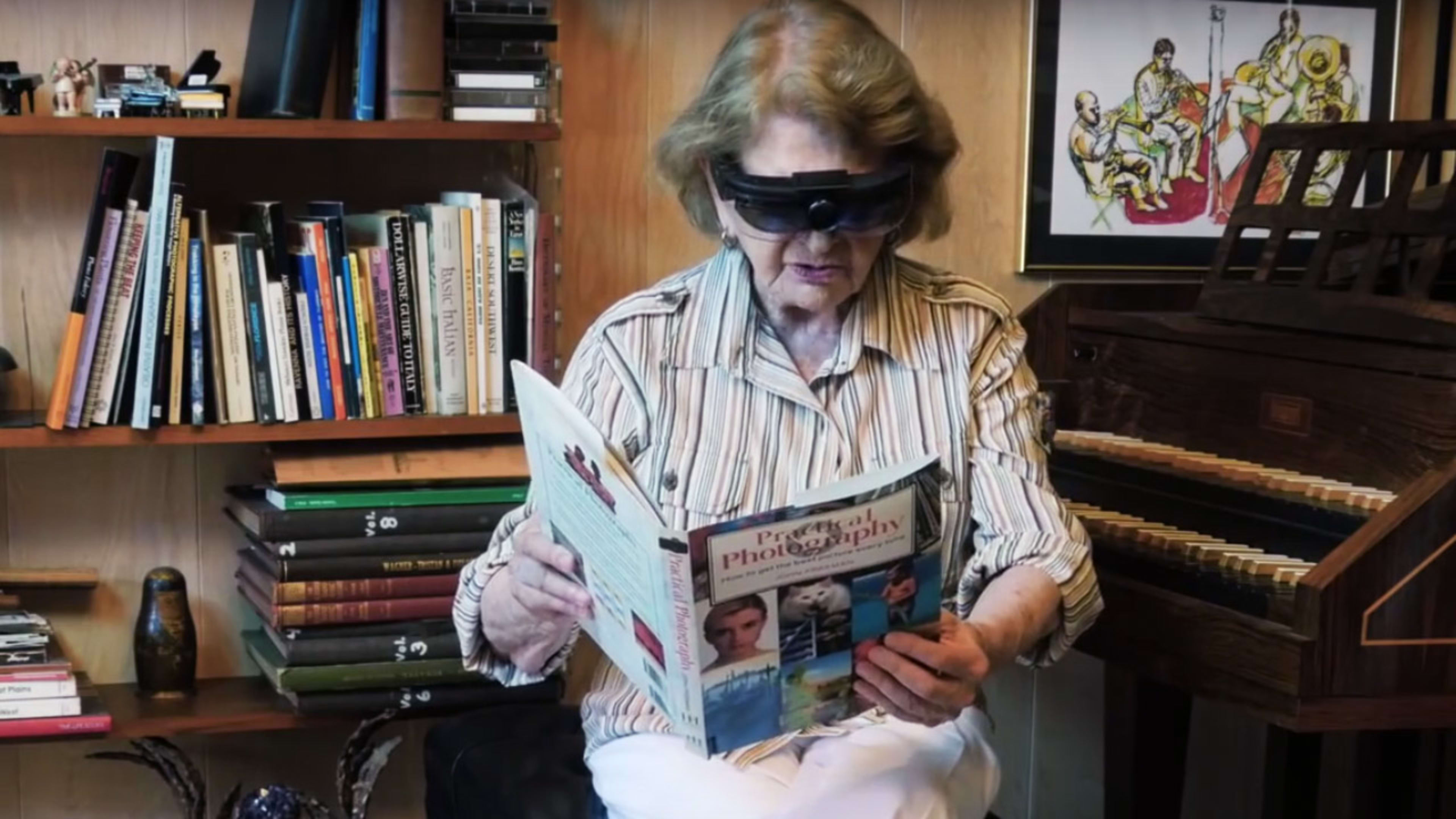There are 285 million visually impaired people globally and Mark Greget and Justin Moore, the founders of the vision tech company NuEyes, saw a huge potential business if only they could come up with a wearable technology capable of helping even a fraction of those who have trouble seeing.
For those whose affliction is macular degeneration, a deterioration of the central portion of the retina that impacts as many as 10 million Americans, one of the few available solutions has been a big, 50-pound machine that electronically magnifies the words in the books and magazines they longed to read.
“People [would] say, ‘this is great, but why can’t someone make a pair of electronic glasses that does the same thing?’” said Greget, NuEyes’ CEO.

Greget isn’t the kind of guy to ignore such a big opportunity. At first he researched the market, and then played around in his garage, trying to build the glasses that patients were clamoring for himself. But progress was slow and fruitless and he thought perhaps he could adapt something already on the market. He didn’t find any companies that could provide the answer.
“You’re telling them your use case,” Mark recalls, explaining that patients want to “see a loved one’s face, or read a newspaper. [Companies] looked at me, saying, ‘I don’t understand.’”
Then he met with a stealthy San Francisco tech company called Osterhout Design Group, led by Ralph Osterhout, a man known as an electronics genius.
“The first time I met with ODG,” Greget says, “Ralph wanted to meet with me and talk with me, and it was amazing. He got it in 30 seconds.”
Ears, Eyes, And Mouth
For years, ODG had been developing various technologies and in 2006, Osterhout decided to focus his company aggressively on head-borne computing, says Nima Shams, ODG’s vice president of head-worn devices. “The eyes, ears, and mouth,” Shams said, “we want to go after this.”
ODG is justifiably proud that it set up shop years ago right in the middle of San Francisco’s tech community, bringing on 85 employees, and making its smart glasses for government, heavy industry, transportation, and oil and gas customers right on site. All with almost no one even knowing the company was there and, until recently, without any outside investors.
The company only formally announced it existed in 2015, a year after it sold a large part of its original intellectual property portfolio to Microsoft for a reported $100 million to $150 million.
After the sale, ODG “reset the company,” says Shams, and focused on its next products.
At CES in January, ODG unveiled the R-7, the company’s seventh-generation device. Hardly a pair of Warby Parkers, the $2,750 glasses are actually a high-end Android tablet you can wear, aimed at the enterprise market. Partners like NuEyes are exactly what ODG has in mind.

Programmable by a wide range of developers–via ODG APIs and an SDK–for a diverse set of applications, a pair of R-7s are a high-quality movie player, an augmented-reality and virtual-reality headset, and the kind of electronic glasses NuEyes’ customers were demanding, all rolled into one.
Each successive version of ODG’s glasses have gotten more streamlined, leading customers like BMW, Caterpillar, NASA, and many others to get on board.
Packed With Sensors
Built to include sophisticated sensors like gyroscopes, magnetometers, and accelerometers, as well as the latest Wi-Fi, Bluetooth, and voice-recognition systems, a 4-megapixel camera, and global navigation satellite system technology, plus a powerful Qualcomm Snapdragon 805 processor, R-7 users have a wealth of options for what to do with the glasses.
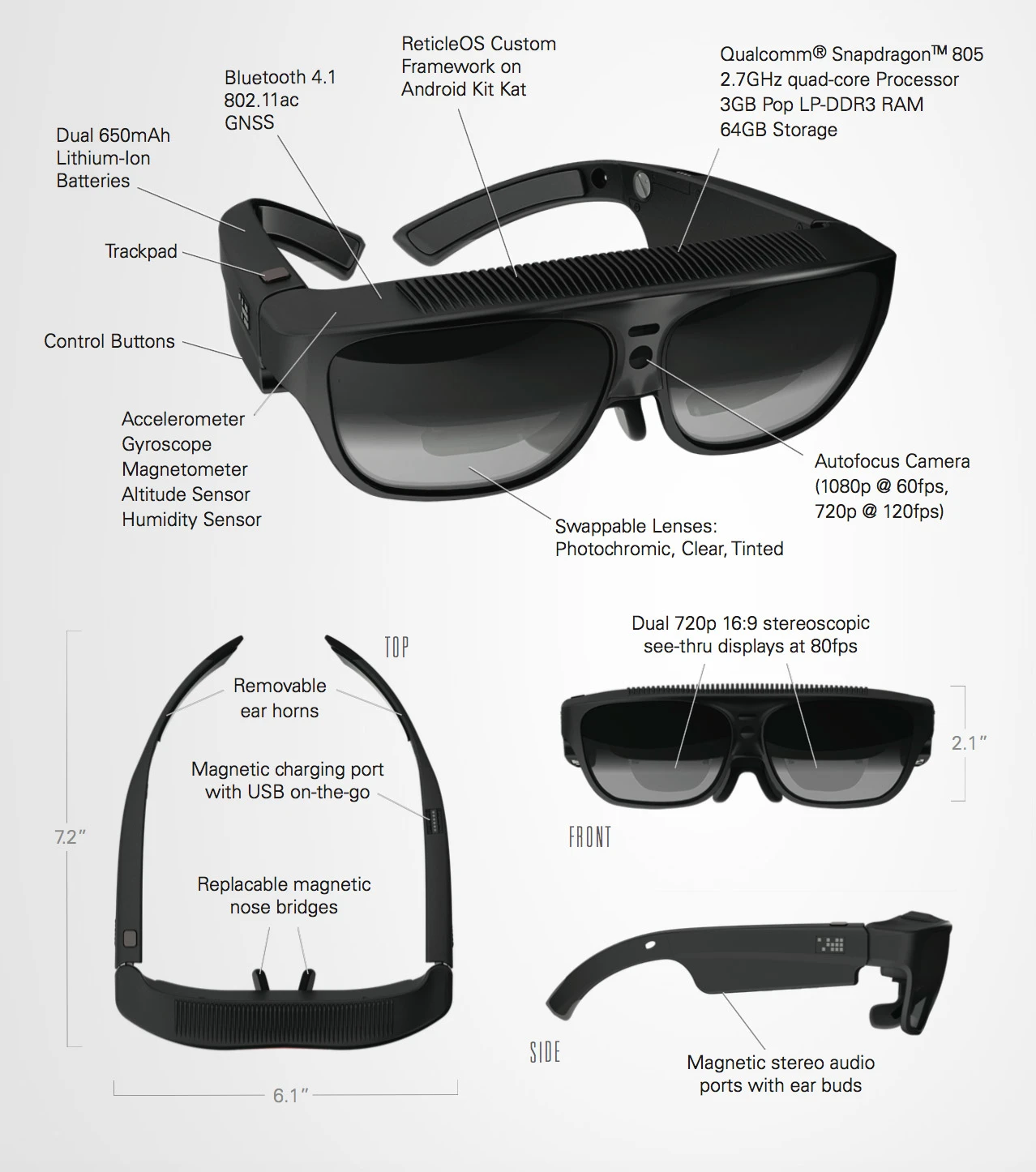
That includes using them as a virtual reality headset, since the glasses know where the user is turning his or her head, and because it’s possible for the screen to automatically block all light coming in from the outside, or as an augmented reality system that can superimpose all kinds of data over the user’s view. There’s also what Shams calls “assisted reality,” where a user can, for example, look at someone and have that person’s bio pop up, or where the user can be trying to assemble something, and instructions automatically appear on the screen as a step-by-step guide.
Still, the real magic, Shams says, is the R-7’s displays.
Each lens features an independently driven 720p lens capable of showing content at 80 frames per second and with full 3-D visualization. Yet because these are glasses, the lenses were designed to be 80% transparent. “They’re like reading glasses,” Shams says. “You wear them and you see the real world with digital content superimposed on top.”
The Three Pillars
The R-7, and all ODG glasses that come after them, “stand on three pillars,” Shams said. The first is immersive, cinema-quality displays with no visual pixels, and true color. The second is full integration in the 5.5-ounce device, meaning no cables, no connection to an external computer, and no battery pack required. And finally, extreme mobility, he says, meaning that the glasses are meant to be fully mobile, for use indoors or outdoors, whether it’s under a truck you’re repairing, or out on a sidewalk in bright sunshine.
Or you can watch a movie on the R-7, and it’s the equivalent, in terms of how our eyes see it, of watching on a 65-inch HD screen from eight feet away.

ODG developed its own Android-based operating system for the glasses, known as Reticle OS. “If you’re an Android developer, [your apps] just natively work,” Shams says.” Android is the largest community of developers out there, so we wanted to stand on the back of giants.”
That’s exactly what developers like NuEyes needed—the ability to design as if for a tablet, but one that a visually impaired customer would wear like glasses.
Those suffering from macular degeneration struggle with things like central-vision loss, requiring significant magnification in order to decipher things like which letter of the alphabet they’re looking at.
For NuEyes, the R-7 offered the ability to give patients glasses with sophisticated variable magnification and contrast adjustment.
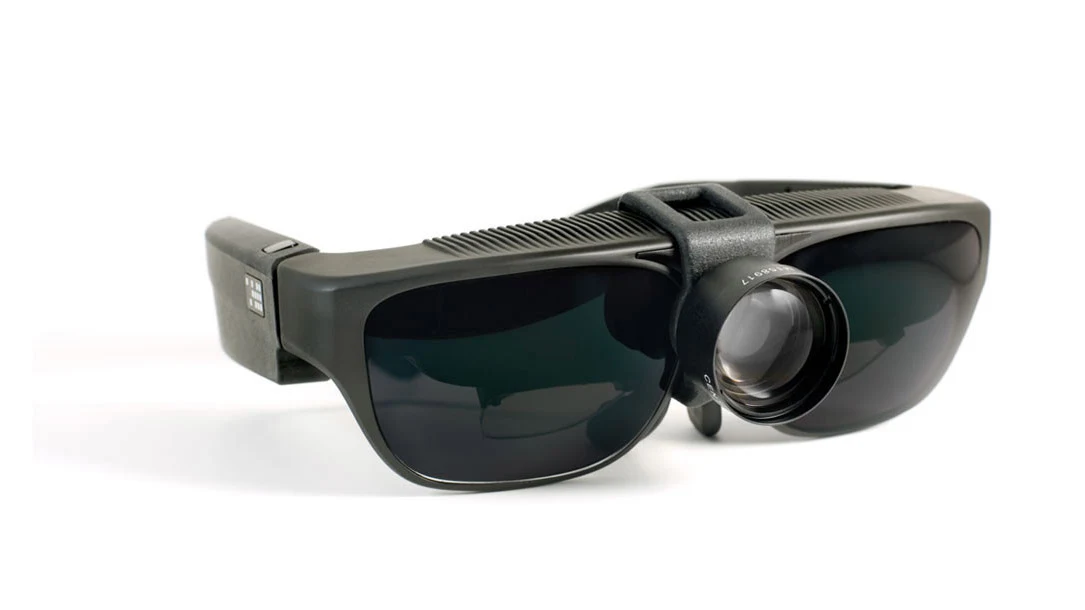
“When people get older, they’ll have multiple eye issues,” Justin Moore, NuEyes’ cofounder and COO says. “By having flexibility built into the glasses, you can address several [issues] with one item.”
NuEyes created proprietary software aimed at addressing many low-vision sufferers’ issues, and it was able to upload that software to the R-7. That meant its customers could take advantage of its technology without needing one of those old 50-pound machines.
The software has voice inputs, Greget explains, which lets users speak their commands to the glasses, things like making text bigger or smaller, or changing the color. They can even say, “‘NuEyes, watch TV,’” he says, “and it will stream TV” in a way that the users can actually see.
Broadly Customizable
Because the ODG glasses are broadly programmable, NuEyes has been able to tailor R-7s to address light sensitivity by offering the ability to go dark on command. The glasses can also incorporate telescopic lenses, which when used to magnify something, don’t pixelate the content, Greget says.
“That’s very important for people who are visually impaired,” Moore says. “If I’m a grandma, I want to watch my grandkids play, or go to the movies,” and the R-7 allows just that.
One of NuEyes’ customers, a 95-year-old woman, just wanted to do something she hadn’t been able to do for years because of her condition.
“To her,” Moore recalls, “the most important thing was playing the piano.”
The woman also was desperate to look at art again, and the glasses will allow her to do both those things. “She’s just so excited to get these,” Moore says. “The first thing she’s going to do is go to the Getty” museum, in Los Angeles, to see art she has never been able to actually see.
There are other medical applications for ODG’s glasses as well. Doctors at hospitals like Johns Hopkins and Stanford are using them to assist with procedures like heart surgery, and some orthopedic surgeons are using the R-7’s augmented-reality tools in conjunction with X-rays in order to adjust zoom and dimension and manipulate imagery that’s never been possible before, and all without using their hands. In essence, Shams says, ODG’s glasses bring surgeons’ monitors right onto their head.
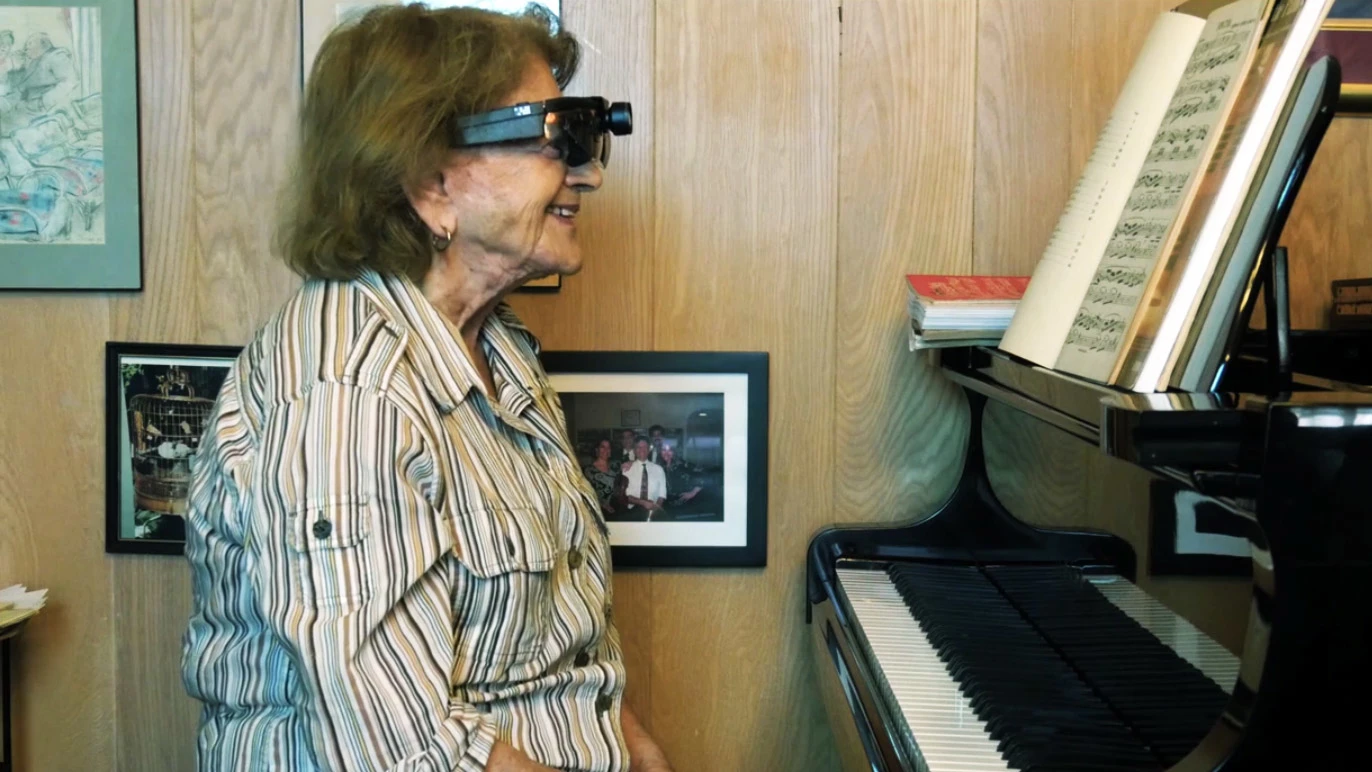
Similarly, the glasses have been found to be ideal for airlines for in-flight emergencies, because they offer doctors on board telepresence capabilities.
ODG’s glasses are also ideal for helping field workers with fixing broken equipment or giving a field operator the information they need to perform routine maintenance, says Michael Campbell, an executive vice president at PTC, an enterprise software company that develops tools for large industrial customers.
Meanwhile, ODG is doing everything it can to help boost sales of the R-7. One step has been to launch an app store for the Reticle OS, Shams said, an Android-based app center for people developing specifically for ODG’s hardware.
Shams notes that it’s important for developers to be able to customize their apps for Reticle OS. As an Android-based system, any app built for Google’s mobile OS will work on a pair of R-7s, “but if you optimize, it’ll be better.”
Up Next: The R-8
And even as ODG is busy selling the R-7, it is already making progress on the next version of its glasses, the R-8.
One big difference with the next model, Shams says, is that the device will improve the video viewing experience. Where currently, watching a movie or TV show on the glasses is the equivalent of being 8 feet away from a 65-inch HD screen, with the R-8 it will be like being in the ideal center-row seat of a movie theater.
ODG is not saying when the R-8 will be available, or how much it will cost.
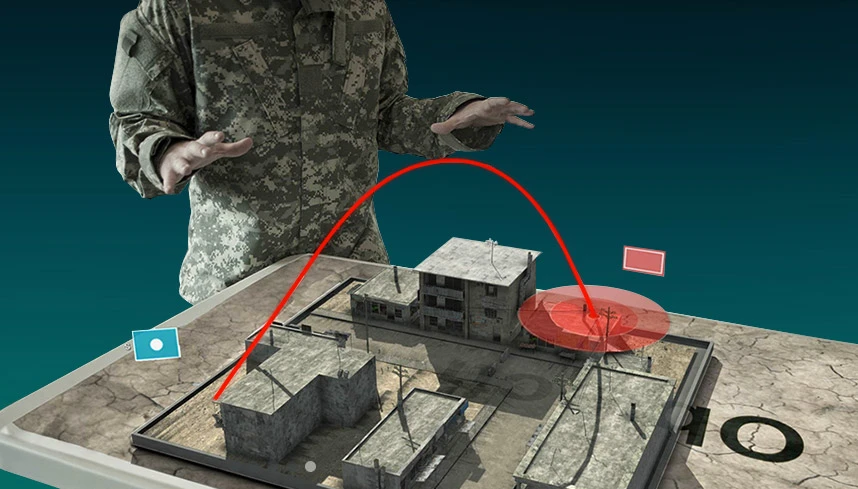
Still, the ability to give users a high-quality movie or TV watching experience was surely the inspiration for what recently became the first outside investment ODG has taken. In January, 21st Century Fox, via its Fox Innovation Lab–which is developing the Hollywood studio’s virtual reality projects, as well as focusing on new TV technology–announced it had made a strategic investment in ODG.
“Our agreement with ODG underscores the innovation we are bringing to market through our Fox Innovation Lab, most recently with VR experiences for The Martian and Wild,” Jim Gianopulos, chairman and CEO of 20th Century Fox Film, said in a statement at the time. “We look forward to partnering with ODG and serving as its lead outside investor as the ODG team pushes the film experience into the future with its high-definition, cinema-wide field of view technology.”
Recognize your brand’s excellence by applying to this year’s Brands That Matter Awards before the early-rate deadline, May 3.
